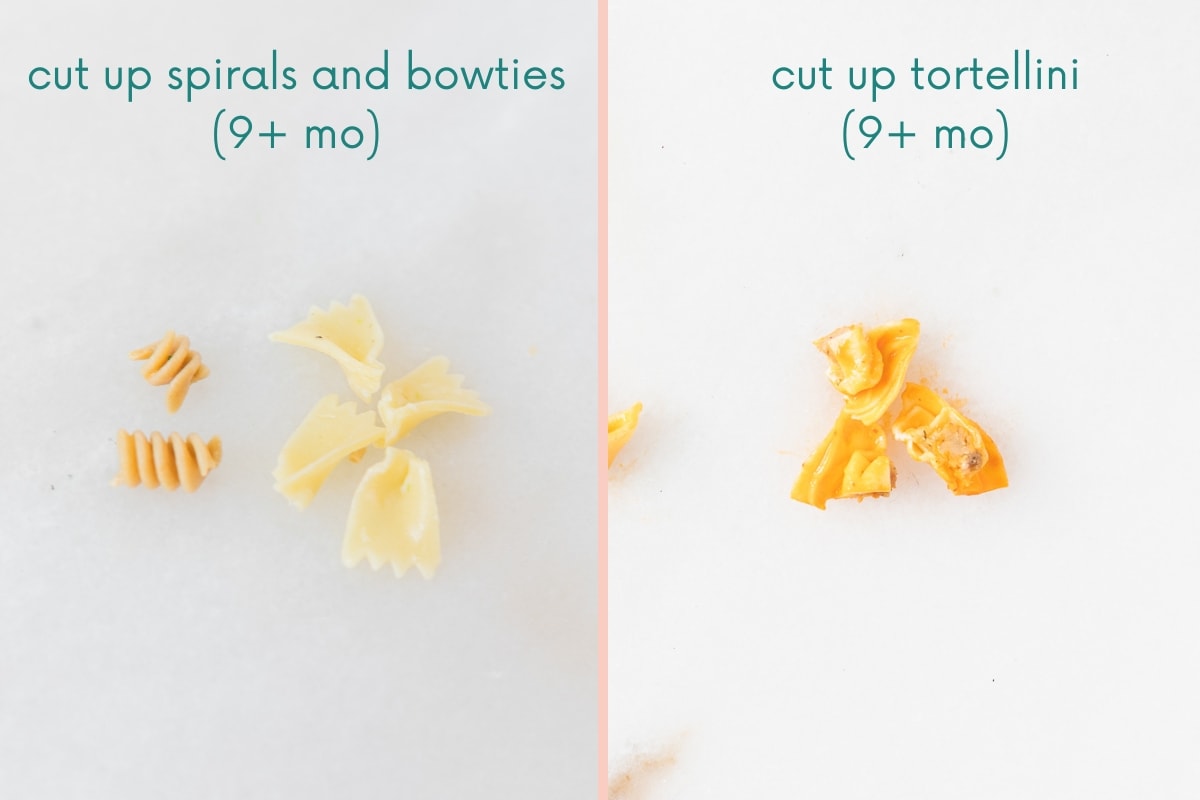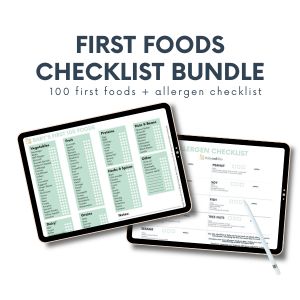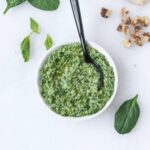The texture of pasta makes it a great food for babies in the finger food stage and baby led weaning! Here are the best pastas and pasta shapes for babies, plus tips on how to serve pasta with baby led weaning.

Pasta is almost always a hit at family mealtime, especially with little ones! It may not be the top of mind as a healthy first food for babies, but it certainly can be if you're mindful. And if it means the whole family is happy with one meal, it's always a win. Here is what you need to know about serving pasta to babies, including which pastas are healthiest, the best shapes for babies, and how to serve pasta with a baby led weaning approach. I'll also include some suggestions for making pasta a more nutritious meal.
Jump to:
When Can Babies Have Pasta?
Babies can eat pasta as soon as they are developmentally ready for solids, around 6 months of age. This is especially true when you're using a baby led weaning approach. If you're going the traditional feeding route, your baby can have pasta once they get to the finger foods stage.
Note: Pasta typically contains common allergens - wheat, egg, or both. If you've already introduced these allergens into your baby's diet with no issues, then you should be just fine! If you haven't, you may choose to introduce wheat and egg separately first to observe for possible allergic reactions.

Why Pasta is a Great First Food
The soft, gummable texture and neutral taste of cooked pasta make it a great first food to include in your little one's diet. Noodles are available in a wide variety of shapes that are appropriate for baby led weaning and babies in the finger food stage, making it easier for them to grasp.
Pasta provides plenty of carbohydrates for baby's high energy needs. It is a great vehicle for nutrient-rich sauces, like tomato sauce, meat sauce, or butternut squash sauce. Noodles also come in all kinds of varieties, from whole wheat pasta to bean based pasta, that can increase the nutrients in each little bite.
Pasta also often contains common allergens: wheat, egg or both. We want to include these in the diet early and frequently to reduce development of a food allergy!
Healthiest Pastas for Babies
When it comes to nutrition, pasta can range based on the ingredients. Simple, unenriched wheat pasta made from white flour will be less nutrient dense than pasta made from beans or legumes. Enriched pasta, which has added vitamins and minerals, has more B vitamins. My top picks for babies (and the whole family) nutrition wise include chickpea pasta, such as Banza, which isn't too far off from regular pasta in taste and appearance, or whole wheat pasta if you want something that will be more acceptable to the whole family but still more nutritious than regular white pasta. But at the end of the day, it come down to what your baby will eat, and the nutrient density of the full dietary pattern. Here is a breakdown of some basic nutrition values in different types of pasta. As you can see, bean-based pastas like chickpea and lentil pasta have more protein and iron, both important for baby's growth.
| Pasta (¼ cup serving) | Carbs (g) | Protein (g) | Fiber (g) | Iron (mg) | Zinc (mg) | Folate (mcg) |
|---|---|---|---|---|---|---|
| Unenriched Wheat Pasta (regular white pasta) | 8 | 1.5 | 0.5 | 0.13 | 0.14 | 1.8 |
| Enriched Wheat Pasta | 8 | 1.5 | 0.5 | 0.34 | 0.14 | 19.5 |
| Enriched Egg Noodles | 10 | 1.8 | 0.5 | 0.59 | 0.26 | 33.5 |
| 100% Whole Wheat Pasta | 8 | 1.6 | 1 | 0.46 | 0.36 | 5.6 |
| Brown Rice Noodles | 10.5 | 1.1 | 0.6 | 0.17 | 0.47 | 1.3 |
| Chickpea Pasta | 8 | 3.5 | 2 | 1.35 | n/a | n/a |
| Lentil Pasta | 8 | 3.5 | 1.5 | 0.75 | 0.5 | n/a |

Best Pasta Shapes for Baby Led Weaning
The best pasta shapes for baby led weaning are long, tubular shapes, such as penne, rigatoni, ziti, cavatappi, or spirals, which are easier for baby to grip. Wide, flat noodles, like egg noodles, fettuccine, or pappardelle (cut into smaller strips) are also good. Bowtie noodles and ravioli can be cut into longer, strip-like pieces. Spaghetti is okay for little ones, but it will be a little harder for them to pick up and get into their mouths - resulting in more mess and less food consumed! Think of the shape of pasta like other foods for baby led weaning: in the early months especially, you want close to the shape and size of your pinky finger.
At 6 months old, it's best to avoid small shapes such as macaroni, shells, and orecchietti, since they can be more difficult to pick up, and if swallowed without chewing have more potential to cause choking and gagging. When baby advances to a pincer grasp, you can cut introduce these shapes cut into small pieces.
How To Serve Pasta for Baby Led Weaning by Month
Tip: When cooking pasta for baby, aim for somewhere between al dente and mush. You don't want the noodles to be too firm, but you don't want them to fall apart when baby is trying to grasp them, either. Cook about 1 minute pasta the el dente time on the instructions and check the texture.

6+ months: Long Tubular Shapes or Chopped Thin Noodles
For the earliest eaters where babies still use a palmar grasp (or scooping motion), serve long, tubular shapes such as penne whole so that baby can grip them with is fist. You can also cut other noodles, such as bowties or large ravioli into strip shapes. Another option is to serve long, thin noodles like spaghetti chopped into bite-sized pieces in a bowl for scooping by hand.
Tip: If you have kitchen shears, you can use them to easily cut noodles into small pieces!

9+ months: Cut Into Small Pieces
Once baby develops a pincer grasp, where he can pick up small objects with index finger and thumb (usually around 9 months), you can offer most pasta shapes cut into very small pieces, about the size of you pinky nail. You can also continue to offer pasta in long tubular shapes or chopped spaghetti as above.

12+ Months: Long Thin Noodles
At this stage you can start to practice with longer pieces of thin noodles like spaghetti or rice noodles, if you'd like. You can offer a baby fork for practice, or let baby explore with hands. This is of course optional, and you can progress as you feel ready! The two options above are still great as your little one progresses into toddler years.
Pasta Serving Suggestions for Babies (and Toddlers!)

Please don't serve just plain noodles! As stated above, I love pasta for babies because it serves as a great vehicle for nutritious sauces and add-ons. And it's an easy meal the whole family will love. Here are some of my favorite baby led weaning friendly pasta add-ons to make noodles into a more complete, balanced meal.
- Tomato sauce and Beef Meatball Fingers
- Creamy Butternut Squash Sauce
- Classic meat sauce (try adding lentils or shredded carrots into your favorite meat sauce!)
- Pesto (It typically has nuts so make sure you've introduced those already.)
- Chopped spinach or finely chopped broccoli with a creamy white sauce
- Olive oil and parmesan
- Green spinach avocado pasta sauce by MJ and Hungryman
FAQ
Yes. Many pastas contain wheat, egg or both, which are common allergens. Make sure you have safely introduced both allergens before offering pasta to baby. Gluten-free pastas such as bean-based pasta may or may not have egg, so check the ingredients label.
No, pasta is not a common choking hazard since the texture is nice and soft. Make sure you cook noodles past al dente for babies and serve appropriate shapes. Serving noodles with a sauce or a drizzle of oil can reduce gagging.
Bean-based pastas, such as chickpea or lentil pasta, tend to be higher in important nutrients such as protein and iron. If your family doesn't care for those, whole wheat pasta is another good option.
Hold off on offering boxed mac and cheese for at least a year, if possible. It typically contains a very high amount of sodium.


















Leave a Reply